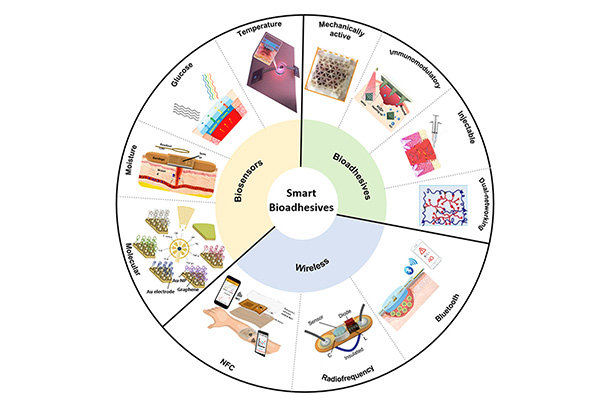
A team of researchers led by Huanyu “Larry” Cheng, James L. Henderson, Jr. Memorial Associate Professor of Engineering Science and Mechanics in the Penn State College of Engineering reviewed the latest science behind bioadhesives. This graphical illustration shows the three major research areas within the field of bioadhesives. Credit: Jia Zhu
Smart bandages may be viable wound care remedy, review finds
August 9, 2022
By Mariah Chuprinski
UNIVERSITY PARK, Pa. — Smart bandages that can sense skin conditions and administer medication at wound sites may be on the horizon as a healing remedy, according to Penn State researchers. They recently reviewed the field’s latest developments in Bioactive Materials.
Known as smart bioadhesives, the innovative products combine biosensors, wireless communication methods and drug delivery to monitor and treat wounds in real time, according to Huanyu “Larry” Cheng, James L. Henderson, Jr. Memorial Associate Professor of Engineering Science and Mechanics in the Penn State College of Engineering.
“We hoped to show the power of the potential opportunities in biodegradable bandages, including what has been done and what can be used as leverage in future studies,” Cheng said.
Cheng’s team first looked at four different types of hydrogel bioadhesives, which adhere to tissues and fold together the two sides of a wound. The four types of adhesives, each with their own properties and strengths, are complementary and can be combined to improve performance, researchers found.
“Bioadhesives provide a scaffold upon which cells can grow,” Cheng said. “Acting similarly to a traditional skin graft, the bioadhesive can increase the speed of the healing process by promoting cell growth across the tissues.”
Hidden within the bioadhesives are biosensors, according to the review, which monitor wounds’ biomarkers, such as temperature, pH level and moisture level, in order to assess their potential for infection. If a wound is too dry, it will heal at a slower rate, for example, and if too wet, it will stimulate bacteria growth and infection.
“We found that the collective information from multiple or all of these types of sensors is often needed to inform the wound status,” Cheng said. “Sensing data can provide useful information to help doctors diagnose chronic wounds without removing bandages and further develop optimal treatment strategies throughout the healing process.”
When combined with sensors, closed-loop wireless communication methods can allow data about a wound to be easily transmitted back to a wearer or health care provider, Cheng said. The wireless design allows the bioadhesive to be more comfortably worn.
“We reviewed studies that tested radiofrequencies, Bluetooth communication and near-field communication methods to transmit wound data to users,” Cheng said. “We found that each of them has a merit in certain but different applications. Near field communication, for example, provides very secure data transmission, but can only over short distances, while radio frequency antennas can transmit data over longer distances.”
In the same closed-loop system, researchers integrated drug delivery within the adhesive to deliver treatment based on patients’ biomarkers – solidifying an all-in-one remedy for wounds. In the future, Cheng’s team plans to use the literature as a basis upon which to develop and test their own smart bioadhesives.
In addition to his appointment in engineering science and mechanics, Cheng is affiliated with the Materials Research Institute, the Institutes of Energy and the Environment, the Institute for Computational and Data Sciences, the College of Earth and Mineral Sciences and several departments within the College of Engineering, all at Penn State.
In addition to Cheng, Jian Yang, from the Penn State Department of Biomedical Engineering, and Yuan Lin, from the University of Electronic Science and Technology of China, served as co-principal investigators on the study. Other contributors include Jia Zhu, Senhao Zhang and Flor Itzel Parra Rodriguez, Penn State Department of Engineering Science and Mechanics; Ethan Gerhard, Penn State Department of Biomedical Engineering; Taisong Pan, University of Electronic Science and Technology of China; Honglei Zhou, Institute of Flexible Electronics Technology at Tsinghua University, China; and Hongbo Yang, Chinese Academy of Science.
The National Institute of Biomedical Imaging and Bioengineering of the National Institutes of Health, the National Heart, Lung, and Blood Institute of the National Institutes of Health and the National Science Foundation supported this work.



